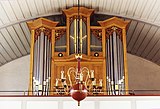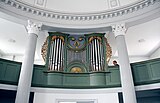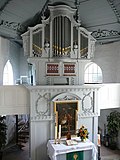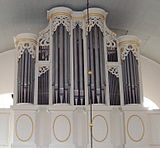Winold van der Putten
Winold van der Putten (born January 27, 1950 ) is a Dutch organ builder .
life and work
Winold van der Putten learned organ building from 1978 at Orgelmakerij Reil in Heerde . In 1989, together with the musician, piano and harpsichord restorer Berend Veger (* 1952), he opened his own organ workshop in Winschoten , which was relocated to Finsterwolde in the former town hall in 1998. After Veger left the company in 1999, van der Putten continued the business alone. After a serious traffic accident in 2002, the employee and master organ builder Ingrid Noack took over the management of the company (director since 2006). The company Mensa Ruiter has been involved in the Finsterwolder company since 2006. With his health gradually recovering, Winold van der Putten returned to his company as a volunteer.
An important project for the company was the construction of the new organ in the Waller Church in 2001/2002. The two-manual instrument was consistently designed in the style of the time around 1650 and built using the traditional craft techniques of that time. It “sets an accent for historical music-making in Bremen”. For this purpose, Van der Putten built its own foundry for the historic sand casting process in collaboration with the former GOArt organ research center at the University of Gothenburg and Harm Dieder Kirschner . The Waller organ has a short octave , subsemitonies (divided upper keys) and a mid-tone tuning .
Van der Putten is known for his reconstructions of medieval positives . So he built several small Gothic organs with Pythagorean tuning (with perfect fifths). They are based on the representation of an organ in the Rutland Psalter (around 1260) and comparable medieval paintings of organs. The structural details were based on descriptions such as the treatises by Theophilus Presbyter and the Bernese Anonymus (both 11th century). The scale length is the same for all pipes (27 or 35 millimeters) and corresponds roughly to the diameter of a pigeon egg, which has led to the name “pigeon egg organ”.
List of works (selection)
The size of the instruments is indicated in the fifth column by the number of manuals and the number of sounding registers in the sixth column. A capital “P” stands for an independent pedal, a lowercase “p” for an attached pedal.
| year | place | building | image | Manuals | register | Remarks |
|---|---|---|---|---|---|---|
| 1990-1991 | Gandersum | Gandersum Church | I. | 5 | Reconstruction of the organ by an unknown organ builder (18th century) using older remains | |
| 1992 | Delmenhorst | City Church of the Holy Trinity | I. | 3 | Construction of a new chest organ | |
| 1994-1995 | Neermoor | reformed Church | I / P | 11 | Restoration of the organ by Hinrich Just Müller (1796–1798) | |
| 1995 | Heiligerlee | Graaf Adolf Kapel | I / p | 12 | New building | |
| 1995 | Gouda (Netherlands) | School association "De Driestar" | II / P | 15th | New building | |
| 1999 | Willum | Village church | I / p | 7th | Restoration of the organ by Van Oeckelen & Zn. (1879) | |
| 1999 | Möhlenwarf | Möhlenwarfer Church | I / P | 9 | Renovation of the organ by Johann Reil (1968) | |
| 1999 | Marsum ( Appingedam ) | Mauritiuskerk | I. | 2 | “Theophilus organ” based on the illustration in the Rutland Psalter, 8 ′ + 6 ′, “Taubenei-Mensur”, manual range g – f 2 (diatonic, with additional b, f sharp 1 and b 1 ) with keys as wide as a hand | |
| 2000 | Tergast | Tergaster Church | I / p | 7th | Reconstruction of the organ by Gerd Sieben Janssen (1840) | |
| 2001-2002 | Walle (Bremen) | Waller Church |

|
II / P | 26th | New building in the style of the 17th century |
| 2003 | Aurich | reformed Church |

|
II / P | 18th | Reconstruction and extension of the organ by Gerd Sieben Janssen (1836–1838) |
| 2006 | Nijmegen | Privately owned | II / p | 6th | New building | |
| 2007-2008 | Altenesch | St. Gallus Church | II / P | 18th | Restoration of the organ by Georg Wilhelm Wilhelmy (1794–1795) | |
| 2010 | Weener | Organeum | Organ function model "Organ for the classroom" | |||
| 2010 | Running BL | Herz-Jesu-Kirche, crypt | I / p | 2 | "Taubenei organ", new construction of a Gothic organ based on a drawing in the Rutland Psalter (around 1260), 8 ′ + 6 ′, manuals A – c 3 (fully chromatic) | |
| 2012 | Hamburg | Privately owned | I. | 3 | "Taubenei-Organ", 8 ′ + 8 ′ + 6 ′, manual scope defga – g 2 a 2 | |
| 2013 | Empty | Mennonite Church | I / P | 9 | Restoration of the organ by Brond de Grave Winter (1860) |
Web links
- official homepage
- Van der Putten organ in Bremen-Walle
- Roland Eberlein : New reconstructions of medieval organs (PDF)
- Estampie on a medieval organ by Van der Putten (at the wind bellows) on YouTube
Individual evidence
- ^ Company history Mense Ruiter Orgelbau , accessed on February 4, 2018.
- ↑ Ars Organi . Vol. 54, 2006, p. 116.
- ^ Uwe Pape , Winfried Topp: Organs and Organ Builders in Bremen. 3. Edition. Pape, Berlin 2003, ISBN 3-921140-64-1 , p. 428.
- ^ Organ in Bremen-Walle , accessed on February 4, 2018.
- ↑ Roland Eberlein : New Reconstructions of Medieval Organs (PDF), accessed on February 5, 2018.
- ^ Organ in Gandersum , accessed on February 5, 2018.
- ^ Organ in Tergast (Dutch), accessed on February 5, 2018.
- ^ Organ in Aurich , accessed on February 5, 2018.
- ^ Organ in Altenesch , accessed on February 5, 2018.
- ↑ A New Gothic-Style Organ: The Van Der Putten Instrument in Laufen, Switzerland , accessed on February 5, 2018.
| personal data | |
|---|---|
| SURNAME | Putten, Winold van der |
| BRIEF DESCRIPTION | Dutch organ builder |
| DATE OF BIRTH | January 27, 1950 |







